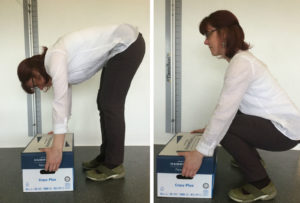
In this month’s blog, we will be discussing the topic of lifting and the reasons for how and why injuries can occur when performing this common every day task. Low back and neck injuries are commonly reported to doctors’ offices and physiotherapy clinics after a bout of repeated lifting or lifting something heavy or awkward. Is the task itself the problem? Is there a “proper” way to lift?
There is uncertainty in the scientific literature as to an optimum technique for lifting. Though lifting injuries are common, the task of lifting itself may not be the problem. Instead the problem may lie in the person’s inability to tolerate repetitive or heavy loads when performing the task. Essentially, injury results when the body’s tolerance to the load is exceeded, regardless of the technique used to lift. However, during your recovery from injury it may be that modifying your lifting technique may allow you to complete this task while avoiding re-aggravation of your symptoms. Your physiotherapist can guide you as to how soon and how much you should lift, as well as how to best approach these tasks again.
It has been shown that total spinal loads during lifting are very similar between the stoop and squat techniques. However, the distribution of these loads is different between the two techniques. The most consistent finding for reducing spinal loads is the load proximity to the body, with the lowest spinal loads occurring when lifting an object between the feet. Other factors that increase your risk of injury during lifting, unrelated to technique, include:
- Lifting while fatigued
- Large fluctuations in the total amount of load lifted day-to-day. For example, if you’ve been required to lift 15lbs occasionally throughout the day and then are required to lift 50+ lbs more frequently the next day/week, you are at increased risk for injury
Therefore, what is important is maintaining a certain level of conditioning and strength as well as recognizing your load tolerance.
Additional Points
- Know the object’s weight
- Plan a clear path
- Use a full grip to lift (not just a few fingers)
- Don’t obstruct your vision when carrying
- Don’t jerk or lift quickly
- Push a load rather than pulling if possible
- Wear proper footwear
So, is the stoop or squat technique better for lifting? The answer is “it depends.” Some patients with hip restrictions (for example, after a hip replacement) are not allowed to flex their hips past 90 degrees which prohibits them from squatting. Some patients have spinal conditions that worsen with flexion loads which prohibits them from using the stoop technique. If in doubt, check with your physiotherapist to see which technique would be ideal for you. Whichever technique is ideal for you, be sure to strengthen the specific muscles required for the technique. And keep the load as close to your body as possible!
Submitted by Matt Fitzsimmons and Albert Chan

